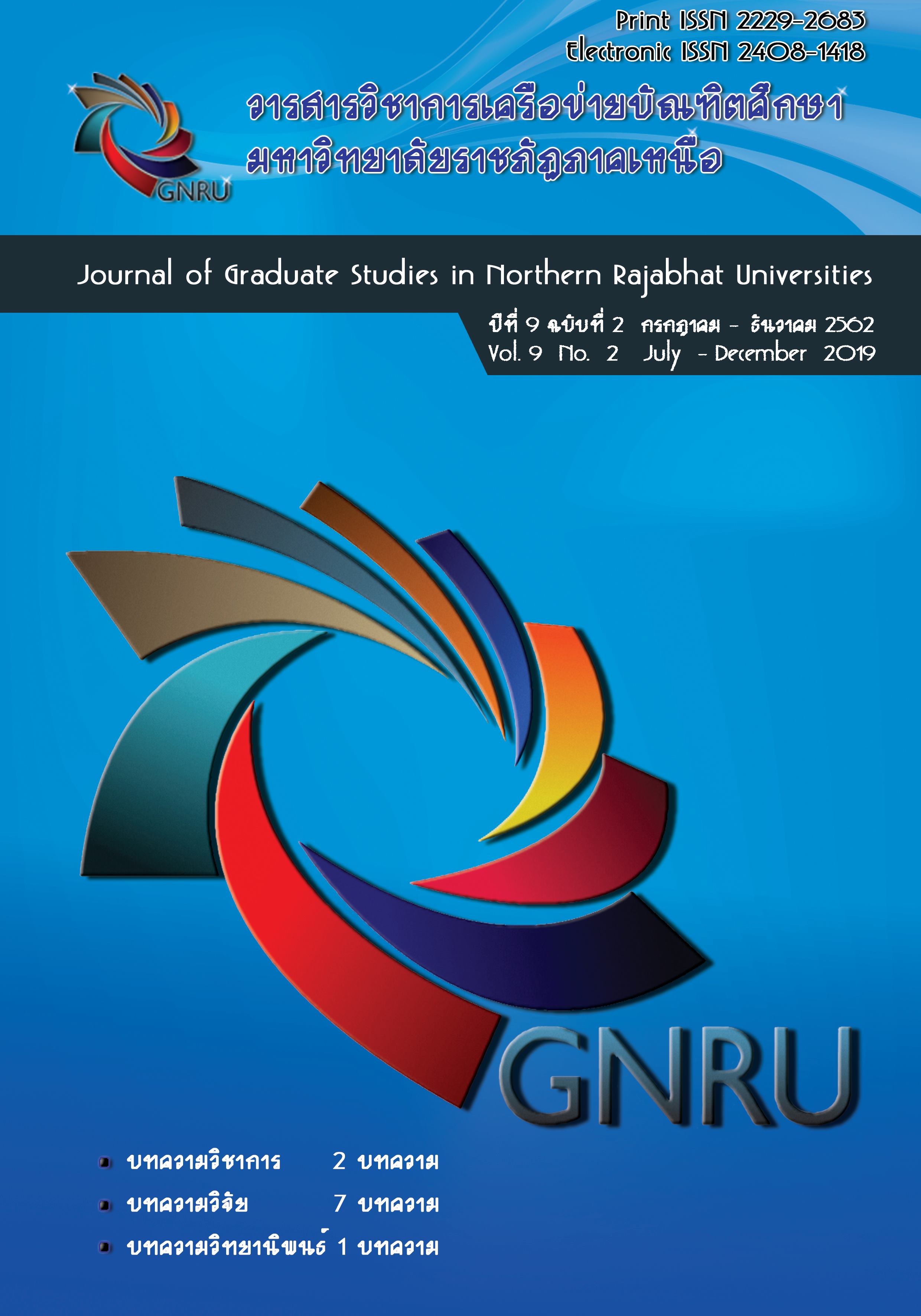ปัจจัยสำคัญของการเรียนรู้ประสบการณ์ข้ามวัฒนธรรม Important Factors for Cross-cultural Experiential Learning
Main Article Content
บทคัดย่อ
การวิจัยนี้มีวัตถุประสงค์เพื่อ (1) ศึกษาทักษะทางสังคม และคุณลักษณะที่พึงประสงค์ ของนักศึกษาและบุคลากรในศตวรรษที่ 21 และ (2) ศึกษาปัจจัยสำคัญของการเรียนรู้ประสบการณ์ข้ามวัฒนธรรม ประชากร คือ บุคลากรและนักศึกษาระดับปริญญาเอก จากมหาวิทยาลัยราชภัฏพระนคร และจากมหาวิทยาลัยมิสซูรี่-เซนต์หลุยส์ ประเทศสหรัฐอเมริกา ที่เข้าร่วมโครงการแลกเปลี่ยนเรียนรู้งานวิจัยและวัฒนธรรมไทย-อเมริกัน ระหว่างมหาวิทยาลัยราชภัฏพระนคร กับ มหาวิทยาลัยมิสซูรี่ – เซ็นหลุยส์ ประเทศสหรัฐอเมริกา ในช่วงปี พ.ศ. 2556 ถึง 2560 จำนวน 88 คน กลุ่มตัวอย่าง จำนวน 20 คน ใช้วิธีการคัดเลือกตามความสมัครใจและความพร้อมในการให้ข้อมูล จำนวนแห่งละ 10 คน คือบุคลากร 2 คน และนักศึกษาระดับปริญญาเอก 8 คน เก็บข้อมูลด้วยวิธีการวิจัยเชิงคุณภาพ 3 ประเภทคือ 1) ผ่านการสังเกตโดยใช้แบบประเมินการเปลี่ยนแปลงพฤติกรรมที่ได้จากการประเมินตนเองและจากการประเมินของผู้ใกล้ชิดที่เข้าร่วมโครงการในระยะเวลาเดียวกัน 2) ผ่านการสัมภาษณ์เชิงลึก และ3) ผ่านการสัมภาษณ์กลุ่มย่อย วิเคราะห์เนื้อหาและลงรหัสข้อมูลตามขั้นตอนของการวิจัยเชิงคุณภาพ และตรวจสอบความน่าเชื่อถือด้วยเทคนิคการวิเคราะห์สามเส้า ผลการวิจัยพบว่า (1) ทักษะทางสังคมที่จำเป็น คือทักษะการใช้ภาษาอังกฤษในการติดต่อสื่อสารได้อย่างมีประสิทธิภาพ ทักษะการใช้เทคโนโลยีสารสนเทศเพื่อการเรียนรู้และพัฒนาตนเองให้เท่าทันกับการเปลี่ยนแปลงของสังคมโลก และทักษะในการเรียนรู้และปรับตัวเพื่อเข้าใจเรื่องการเรียนรู้ข้ามวัฒนธรรมระหว่างสังคมไทยและสังคมอเมริกัน ซึ่งทักษะทางสังคมดังกล่าวข้างต้นนี้ ถือเป็นปัจจัยสำคัญและเป็นรากฐานในการพัฒนาความสามารถในการเรียนรู้ข้ามวัฒนธรรมในศตวรรษที่ 21 และ (2) ปัจจัยสำคัญของการเรียนรู้ประสบการณ์ข้ามวัฒนธรรมสำหรับนักศึกษาและบุคลากรที่เข้าร่วมโครงการแลกเปลี่ยนจะต้องประกอบไปด้วยปัจจัย 4S คือ (1) การศึกษาและทำความเข้าใจเกี่ยวกับวัฒนธรรมของผู้อื่น (Study) (2) การให้พื้นที่การแสดงออกสำหรับวัฒนธรรมอื่นและการยอมรับพฤติกรรมของบุคคลอื่นที่แตกต่างจากตนเอง (Space) (3) การสร้างกลยุทธ์ในการทำงานร่วมกับผู้ที่มาจากวัฒนธรรมอื่น (Strategy) และ (4) การเริ่มต้นลงมือปฏิบัติโดยการสร้างความสัมพันธ์ที่ดีกับผู้ที่มาจากวัฒนธรรมอื่น (Start)
Article Details
เอกสารอ้างอิง
ถนอมพร เลาหจรัสแสง. (2556). ทักษะแห่งศตวรรษที่ 21 เพื่อการพัฒนาอาจารย์ของมหาวิทยาลัยเชียงใหม่: 21st Century Skills for CMU Faculty Development. สำนักบริการเทคโนโลยีสารสนเทศ. เชียงใหม่: มหาวิทยาลัยเชียงใหม่.
นพรัตน์ นาชาสิงห์. (2551). การศึกษาเปรียบเทียบทักษะทางสังคมของนักเรียนชั้นมัธยมศึกษาปีที่ 3 จังหวัดสุโขทัยที่มีระดับการให้เหตุผลเชิงจริยธรรมด้านพรหมวิหารสี่และประสบการณ์ทางสังคมแตกต่างกัน. ปริญญานิพนธ์การศึกษามหาบัณฑิต (การวิจัยและสถิติทางการศึกษา). บัณฑิตวิทยาลัย มหาวิทยาลัยศรีนครินทรวิโรฒ, กรุงเทพฯ.
พนิดา สัตโยภาส และอัจฉรา เมฆสุวรรณ. (2561). ความสัมพันธ์เชิงสาเหตุระหว่างผู้ประกอบการและการมุ่งเน้นการตลาดที่ส่งผลต่อความได้เปรียบในการแข่งขันของธุรกิจโรงแรมขนาดเล็ก จังหวัดเชียงใหม่. วารสารวิชาการเครือข่ายบัณฑิตศึกษามหาวิทยาลัยราชภัฏภาคเหนือ, 8(14), 27-40.
วรินทร สุภาพ. (2561). ผังมโนทัศน์: เครื่องมือสำคัญสำหรับการจัดการศึกษาคณิตศาสตร์ในศตวรรษที่ 21. วารสารวิชาการเครือข่ายบัณฑิตศึกษามหาวิทยาลัยราชภัฏภาคเหนือ, 8(14), 1-14.
วิจารณ์ พานิช. (2558). วิถีสร้างการเรียนรู้เพื่อศิษย์ในศตวรรษที่ 21. วารสารนวัตกรรมการเรียนรู้, 1(2), 28-36.
สุขุมาล เกษมสุข. (2535). การสอนทักษะทางสังคมในชั้นประถมศึกษา. กรุงเทพฯ: ภาควิชาหลักสูตร และการสอน มหาวิทยาลัยศรีนครินทรวิโรฒ ประสานมิตร.
Alkin, M. & Christie, C. (2004). An evaluation theory tree. In Alkin, M. C. Evaluation roots (pp. 13-65). Thousand Oaks, CA: SAGE. doi: 10.4135/9781412984157
Beck, U. (1992). Risk society: Towards a new modernity (M. Ritter, Trans.). London: Sage.
Bencze, L., & Carter, L. (2011). Globalizing students acting for the common good. Journal of Research in Science teaching, 48(6), 648-669.
Bolton, R. (1979). People Skills: how to assert yourself, listen to others, and resolve conflict. New York: Simon & Schuster.
Chung, Y., Yoo, J., Kim, S. W., Lee, H., & Zeidler, D. L. (2016). Enhancing students’ communication skills in the science classroom through socioscientific issues. International Journal of Science and Mathematics Education, 14(1), 1-27.
Denzin, N. K. (1978). The logic of naturalistic inquiry. In N. K. Denzin (Ed.), Sociological methods: A sourcebook (2nd ed.). New York: McGraw-Hill.
Department of Health, Education. (2014). The Belmont Report. Ethical principles and guidelines for the protection of human subjects of research. The Journal of the American College of Dentists, 81(3), 4.
Engberg, M. E. (2007). Educating the workforce for the 21st century: A cross-disciplinary analysis of the impact of the undergraduate experience on students’ development of a pluralistic orientation. Research in Higher Education, 48(3), 283-317.
Esquith, R. (2007). Teach Like Your Hair's on Fire: The Methods and Madness Inside Room 56. New York, USA:Viking.
Faherty, V. (2010). Wordcraft: Applied Qualitative Data Analysis (QDA): Tools for public and voluntary social services. Thousand Oaks, CA: Sage.
Farmer, T, Robinson, K, Ellioll, S. J., & Eyles. J. (2006). Developing and implementing a triangualation protocal for qualitative health research. Qualitative Health Research, 16(3), 377-394.
Flick, U. (2006). An introduction to qualitative research. (3rd ed.). London: Sage.
Glaser, B., & Strauss, A. (1967). The discovery of grounded theory. Chicago: Aldine.
Golafshani, N. (2003). Understanding Reliability and Validity in Qualitative Research. The Qualitative Report, 8(4), 597-606. Retrieved from https://nsuworks.nova.edu/tqr/vol8/iss4/6
Gretter, S., & Yadav, A. (2016). Computational thinking and media & information literacy: An integrated approach to teaching twenty-first century skills. Tech Trends, 60(5), 510-516.
Hall, E.T. (1976). Beyond Culture. Garden City NY: Anchor.
Hammond, C. D., & Keating, A. (2018). Global citizens or global workers? Comparing university programmes for global citizenship education in Japan and the UK. Compare: A Journal of Comparative and International Education, 48(6), 915-934.
Hancock, D. R., & Algozzine, R. (2006). Doing case study research: A practical guide for beginning researchers. New York: Teachers College Press.
Hofstede, G. (1982). Intercultural Co‐operation in Organisations. Management Decision, 20(5), pp.53-67. https://doi.org/10.1108/eb001305
Hofstede, G. (1991). Cultures and Organizations: Software of the Mind. London: McGraw-Hill U.K.
Hofstede, G. (2011). Dimensionalizing Cultures: The Hofstede Model in Context. Online Readings in Psychology and Culture, 2(1). https://doi.org/10.9707/2307-0919.1014
Inglehart, R. (2018). Culture shift in advanced industrial society. Princeton, New Jersey: Princeton University Press.
Knalf, K., & Breitmayer, B. (1991). Triangulation in Qualitative Research: Issues of Conceptual Clarity and Purpose. In J. Morse (Ed.), Qualitative Nursing Research: A contemporary Dialogue (pp. 226-239). Newbury Park, CA: Sage.
Levasseur, R. E. (2001). People skills: Change management tool-Lewin's change model. Interfaces, 31(4), 71-73.
Lewin, K. (1947a). Frontiers in group dynamics: Channels of group life: Social planning and action research. Human Relations, 1(2), 143-153.
Lewin, K. (1947b). Frontiers in group dynamics: Concept, method and reality in social science: Social equilibria and social change. Human Relations, 1(1), 5-41.
Lewin, K., & Cartwright, D. (Eds.). (1952). Field theory in social science: Selected theoretical papers. London: Tavistock.
Meadows, L. M., & Morse, J. M. (2001). Constructing evidence within the qualitative project. The nature of qualitative evidence, 187-200.
Merriam, S. B. (1998). Qualitative research and case study applications in education. (2nd ed.). San Francisco: Jossey-Bass.
Minkov, M. (2007). What makes us different and similar: A new interpretation of the World Values Survey and other cross-cultural data. Sofia, Bulgaria: Klasika I Stil.
Morse, J.M., Barrett, M., Mayan, M., Olsen, K., & Spiers, J. (2002). Verification strategies for establishing reliability and validity in qualitative research. International Journal of Qualitative Methods, 1, 13-22.
Patton, M. Q. (2002). Qualitative research and evaluation methods. (3rd ed.). London: Sage.
Riggio, R. E. (1986). Assessment of basic social skills. Journal of Personality and Social Psychology, 51(3), 649-660. Retrieved from https://dx.doi.org/10.1037/0022-3514.51.3.649
Stemler, S. (2001). An overview of content analysis. Practical Assessment, Research & Evaluation, 7, 137–146.
Strauss, A., & Corbin, J. (1998). Basics of qualitative research. (2nd ed.). Thousand Oaks, CA: Sage.
Stufflebeam D.L. (2003). The CIPP Model for Evaluation. In: Kellaghan T., Stufflebeam D.L. (Eds) International Handbook of Educational Evaluation. Kluwer International Handbooks of Education, vol 9 (pp. 31-62). Springer, Dordrecht.
Stufflebeam, D. L. (1971). The use of experimental design in educational evaluation. Journal of Educational Measurement, 8(4), 267-274.
Stufflebeam, D. L., & Shinkfield, A. J. (2007). Evaluation theory, models and applications. San Francisco, CA: Jossey-Bass.
Zubiaga, A., Procter, R., & Maple, C. (2018). A longitudinal analysis of the public perception of the opportunities and challenges of the Internet of Things. PloS one, 13(12), 1-18. e0209472.


